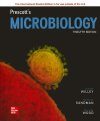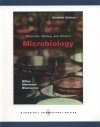About this book
The author team of Prescott’s Microbiology continues to provide a modern approach to microbiology using evolution as a framework. This new 12th edition integrates impactful new changes to include a fresh new design to engage students and important content updates including SARS-CoV-2 and COVID-19 which are prominently featured, taxonomic schemes that have been extensively revised, recent epidemiological data, and mRNA vaccines which just scrapes the surface of this new edition.
Contents
Part One Introduction to Microbiology
Chapter 1. The Evolution of Microorganisms and Microbiology
Chapter 2. Microscopy
Chapter 3. Bacterial Cell Structure
Chapter 4. Archaeal Cell Structure
Chapter 5. Eukaryotic Cell Structure
Chapter 6. Viruses and Other Acellular Infectious Agents
Part Two Microbial Nutrition, Growth, and Control
Chapter 7. Bacterial and Archaeal Growth
Chapter 8. Control of Microorganisms in the Environment
Chapter 9. Antimicrobial Chemotherapy
Part Three Microbial Metabolism
Chapter 10. Introduction to Metabolism
Chapter 11. Catabolism: Energy Release and Conservation
Chapter 12. Anabolism: The Use of Energy in Biosynthesis
Part Four Microbial Molecular Biology and Genetics
Chapter 13. Bacterial Genome Replication and Expression
Chapter 14. Regulation of Cellular Processes
Chapter 15. Eukaryotic and Archaeal Genome Replication and Expression
Chapter 16. Mechanisms of Genetic Variation
Chapter 17. Microbial DNA Technologies
Chapter 18. Microbial Genomics
Part Five The Diversity of the Microbial World
Chapter 19. Archaea
Chapter 20. Nonproteobacterial Gram-Negative Bacteria
Chapter 21. Proteobacteria
Chapter 22. Gram-Positive Bacteria
Chapter 23. Protists
Chapter 24. Fungi
Chapter 25. Viruses
Part Six Ecology and Symbiosis
Chapter 26. Exploring Microbes in Ecosystems
Chapter 27. Microbial Interactions
Chapter 28. Biogeochemical Cycling and Global Climate Change
Chapter 29. Microorganisms in Marine and Freshwater Ecosystems
Chapter 30. Microorganisms in Terrestrial Ecosystems
Part Seven Pathogenicity and Host Response
Chapter 31. Innate Host Resistance
Chapter 32. Adaptive Immunity
Chapter 33. The Microbe-Human Ecosystem
Chapter 34. Infection and Pathogenicity
Part Eight Microbial Diseases, Detection, and Their Control
Chapter 35. Epidemiology and Public Health Microbiology
Chapter 36. Clinical Microbiology and Immunology
Chapter 37. Human Diseases Caused by Viruses and Prions
Chapter 38. Human Diseases Caused by Bacteria
Chapter 39. Human Diseases Caused by Fungi and Protists
Part Nine Applied Microbiology
Chapter 40. Microbiology of Food
Chapter 41. Biotechnology and Industrial Microbiology
Chapter 42. Applied Environmental Microbiology
Appendix 1 A Review of the Chemistry of Biological Molecules
Appendix 2 Common Metabolic Pathways
Appendix 3 Microorganism Pronunciation Guide
Customer Reviews
Biography
Joanne M. Willey has been a professor at Hofstra University on Long Island, New York, since 1993, where she is the Leo A. Guthart Professor of Biomedical Science and Chair of the Department of Science Education at the Donald and Barbara Zucker School of Medicine at Hofstra/Northwell. Dr Willey received her B.A. in Biology from the University of Pennsylvania, where her interest in microbiology began with work on cyanobacterial growth in eutrophic streams. She earned her PhD in biological oceanography (specializing in marine microbiology) from the Massachusetts Institute of TechnologyWoods Hole Oceanographic Institution Joint Program in 1987. She then went to Harvard University, where she spent her postdoctoral fellowship studying the filamentous soil bacterium Streptomyces coelicolor. Dr Willey has coauthored a number of publications that focus on its complex developmental cycle. She is an active member of the American Society for Microbiology (ASM), and served on the editorial board of the journal Applied and Environmental Microbiology for nine years and as Chair of the Division of General Microbiology. Dr Willey taught microbiology to biology majors for 20 years and now teaches microbiology and infectious disease to medical students. She has taught courses in cell biology, marine microbiology, and laboratory techniques in molecular genetics. Dr Willey lives on the north shore of Long Island and has two grown sons. She is an avid runner and enjoys skiing, hiking, sailing, and reading.
Kathleen M. Sandman received her B.A. in Biology from La Salle University and her PhD in Cellular and Developmental Biology from Harvard University. She was inspired to a career in science by her older brother's experience as an organic chemist and by the developing technology in recombinant DNA in the 1970s. Her graduate work used a transposable element as a mutagen in Bacillus subtilis to study gene expression during endospore formation. She continued in the genetics of Gram-positive bacteria with a postdoctoral year studying Bacillus thuringiensis at the University of Cambridge in the United Kingdom. Another postdoctoral opportunity at The Ohio State University provided an introduction to the emerging field of archaeal molecular biology, where Dr Sandman discovered archaeal histones and continued research in the structural biology of archaeal chromatin for about 20 years. She served the National Science Foundation as a research grant reviewer and panellist for the Life in Extreme Environments program and has organized conference sessions on archaeal molecular biology and proteins from extremophiles. Dr Sandman has taught microbiology to hundreds of students, at both the introductory level and in an advanced molecular microbiology laboratory. Dr Sandman has worked as a consultant in a variety of industries, including industrial microbiology, environmental geomicrobiology, and technical publishing. She lives with her husband in Columbus, Ohio, and has two grown daughters. She enjoys biking, fabric arts, reading, and genealogy.
Dorothy H. Wood has taught microbiology and general biology at Durham Technical Community College in North Carolina since 2004. Dr Wood received her B.A. in Biology from Rhode Island College where her love of microbes began, nurtured by Dr Charles Owens. She earned her PhD in Cell and Molecular Pathology from the University of North Carolina at Chapel Hill, focusing on pancreatic damage caused by antimicrobial drugs, and investigated alternative therapies based on receptor binding by novel compounds. After three years as Assistant Professor at NC Central University, Dr Wood made the move to the NC Community College System to focus her attention on her primary interest of teaching. Throughout her career, she has developed several courses, including graduate bacteriology, pathophysiology, and biotechnology. She serves as a visiting scholar at Duke University where she is a mentor for the Preparing Future Faculty program. Dr Wood is a member of the American Society for Microbiology and the Association of College and University Biology Educators, as well as several local organizations that foster pedagogy. She is a digital faculty consultant for McGraw-Hill and has worked on several textbooks in a variety of disciplines, developing and editing digital content to accompany the texts. Outside of the classroom, Dr Wood is a fitness professional, leads health and wellness seminars, and has been the treasurer of a nonprofit organization for the past 10 years. She enjoys life in North Carolina with her husband and two grown children.
































